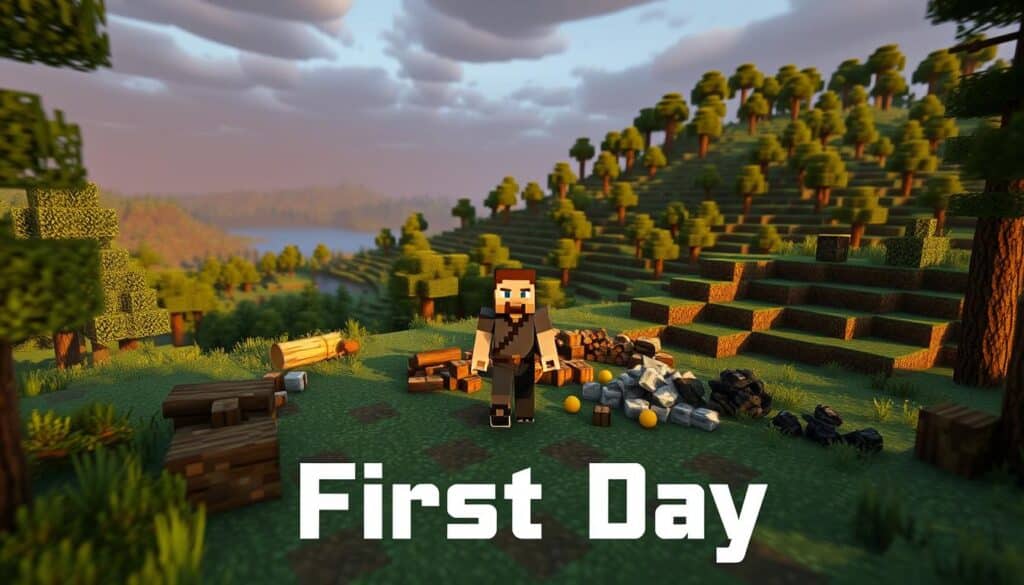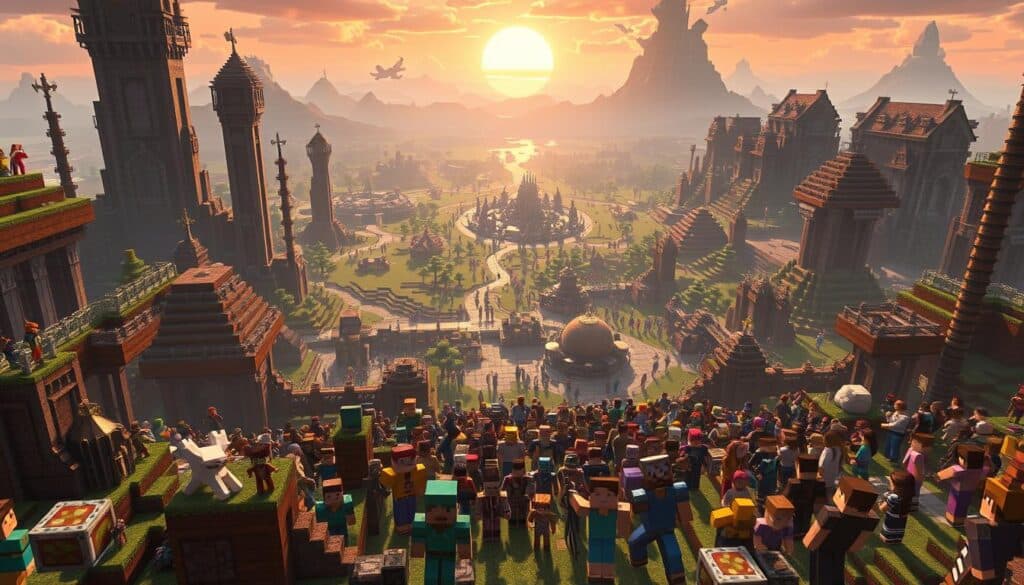Welcome to the Minecraft Survival Guide 2025. This guide is built to help you master your game with clear, friendly advice. Whether you play Java on PC or Bedrock on console, you will find survival Minecraft tips that match current mechanics and the 2025 updates.
Anúncios
Inside, expect step-by-step help from world creation to endgame boss fights. The Minecraft 2025 guide covers seeds, base builds, resource management, combat strategies, enchantments, and travel through the Nether and the End. It also explains key differences between Java and Bedrock where they matter.
We focus on practical, safe advice for single-player and multiplayer sessions. You will get quick-reference checklists, strategies for beginners and advanced players, and guidance on recommended mods and data packs. Install tips include safety notes for Windows and macOS users and console players.
This introduction aligns with the intended Minecraft meta title and description so your search for a reliable survival guide leads here. Read on to build, explore, and thrive—learn smart routines and time-tested tactics to Master Your Game.
Key Takeaways
- This Minecraft 2025 guide covers both Java and Bedrock survival essentials.
- Follow step-by-step advice from world setup through boss encounters.
- Find survival Minecraft tips for beginners and experienced players.
- Includes safe mod and data pack recommendations for Windows and macOS.
- Quick-reference checklists streamline play and speed up progression.
Minecraft Survival Guide: Build, Explore, and Thrive in 2025
This survival guide overview gives US Minecraft players a clear path through the biggest changes and practical tips for 2025. Read short, focused sections to learn new mechanics, adjust strategies, and get faster at survival play.
Overview of what’s new in 2025
Mojang’s 2025 updates bring reworked biomes, refined world-gen, and tweaks to mob behavior that change common tactics. New blocks and a few fresh crops alter farming loops and base design. Redstone timing and some enchantments were adjusted, so builders must retest contraptions. Bedrock and Java keep core features in sync, with occasional divergence in mob AI and cross-platform performance. These shifts reshape resource priorities and spawn patterns for long-term survival.
Why this guide is essential for players in the United States
US Minecraft players use a wide mix of hardware: gaming PCs, PlayStation, Xbox, and mobile devices. This guide tailors tips for those setups and highlights regional concerns like common ISP latencies and console parental controls. It points to U.S.-based server communities and reputable news outlets for patch notes and support. Readers get advice on smoothing multiplayer sessions and on safe account practices that fit the U.S. market.
How to use this guide to level up your gameplay
Follow chapters in order if you are new to survival. Skip to advanced sections for focused help when you need faster builds or boss strategies. Use the quick-start checklists for first-day priorities and printable craft sheets to keep at your desk. Try new mechanics in Creative mode or a copy world before risking your main save. Use the guide as a living resource to test builds, refine farms, and adapt to future Minecraft 2025 updates.
Getting Started: World Creation and Seed Selection
World creation in Minecraft starts with choices that shape every hour of play. Pick a world that fits your goals before you spawn. Small adjustments to seed and settings make the start smoother and keep early goals clear.
Choosing the right world type for survival play
Default is the safest pick for balanced exploration, steady resources, and common biomes. Choose Amplified when you want dramatic cliffs and vertical builds that challenge movement and resource access. Superflat works well for resource-limited challenges, redstone testing, or building without terrain interference.
Java and Bedrock generate worlds differently. Java tends to offer more varied biome layouts and richer structure clusters. Bedrock may place villages and ruins with different frequencies, so test a seed on your platform to ensure it matches expectations.
Pick a survival world type that fits the risk you want: standard survival for steady progression, hardcore for permadeath and high tension, or experimental snapshots for early access to new features.
Top seeds for 2025: biomes, villages, and rare structures
Great seeds put you near valuable structures. Look for spawns with early villages for trading, temples near settlements for quick loot, and rare biomes like mangrove swamps or mushroom fields for unique resources. Mesa and ice spikes still offer memorable builds and resource variety.
Community lists on Reddit, Planet Minecraft, and MinecraftSeeds are good starting points. Confirm any candidate in your version so the map generator matches current best seeds 2025 results. Seed behavior can vary between Java and Bedrock, so testing avoids surprises.
Initial world settings and difficulty considerations
Set difficulty with your goals in mind. Peaceful removes hostile mobs but limits XP and rare drops. Normal fits most players with balanced threat and reward. Hard raises mob damage and adds hunger penalties for veterans. Hardcore locks the game to permadeath for high stakes.
Toggle “Generate Structures” if you want villages and temples. Turn cheats on for creative experimentation or off for authentic survival. Enable autosave or keep regular manual backups to protect progress from crashes or accidental deaths.
Adjust render distance and performance-related settings on low-end machines to improve stability. Lowering particles, smooth lighting, and view distance reduces lag and keeps your early game responsive.
| Choice | Best for | Pros | Cons |
|---|---|---|---|
| Default | Balanced survival | Stable resources, common structures, predictable progression | Less dramatic terrain |
| Amplified | Explorers and builders | Striking landscapes, vertical challenge, scenic bases | Performance heavy, tricky resource access |
| Superflat | Creative testing, challenge runs | Easy building, controlled resource conditions | No natural terrain or ore variety without custom settings |
| Java vs Bedrock | Platform-specific | Java: varied biomes and structure density. Bedrock: consistent cross-play performance | Seeds and structure placement differ between versions |
| Difficulty | Player experience | Peaceful: safe starts. Normal: balanced. Hard/Hardcore: high reward and risk | Higher difficulty increases death risk and resource loss |
Early Game Priorities: First Day to First Night

Start strong with a clear plan for the first 20 minutes. Punch trees for wood, craft a crafting table, make wooden tools, and grab stone to upgrade to stone tools. Gather quick food sources like apples, seeds, and passive mobs to avoid panic later. Use this early game checklist to turn a chaotic spawn into a stable beginning.
Must-have items on your fast start Minecraft list: crafting table, wooden and stone pickaxe, axe, torches, a furnace, and a basic food supply. If you find wool, craft a bed to skip the night. Place torches near your shelter and on the ground to cut down mob spawns.
Speedrunners should aim for nearby villages or exposed caves in the first minutes. Villages often supply beds, food, and basic gear. Trading can net early resources fast. These Minecraft first day tips shave minutes and reduce risk.
Quick shelter designs work for beginners and racers. A dirt hut or a small 2×1 stone block room built into a hillside gives instant protection. A half-buried starter base keeps mobs out and blends with terrain. Rooftop safety keeps you above ground threats until you can fortify.
Defensive details matter: place your door off the main mob path, light interiors and entrances, and seal gaps with blocks. For speedrunners, use minimal bases and bed tricks to reset spawn safely. As you progress, replace wood with stone, add a single chest, and set up a small farm plot beside the furnace.
Early game crafting focuses on conversion and efficiency. Turn logs into planks, planks into sticks, and sticks into tools. Craft torches with coal or charcoal plus sticks. A furnace is essential for cooked food like porkchop or steak, which restore more hunger than raw alternatives.
Keep these essential recipes handy in your mind: crafting table (4 planks), furnace (8 cobblestone), chest (8 planks), bed (3 wool + 3 planks), torches (coal + stick), and basic wooden and stone tools. Choose coal when available, use charcoal as a quick fuel, or renewable bamboo in some biomes for sustainable smelting.
Use the early game checklist and early game crafting steps together to stabilize your first night. With a small shelter, basic tools, and cooked food, you move from survival mode to planning mode faster. That fast start Minecraft routine sets the tone for the rest of your world.
Resource Management and Efficient Farming
Good resource habits speed every play session. Focus on scalable systems that save time and keep you moving toward endgame goals. Mix careful mining with steady renewable sources to avoid long grind sessions.
Mining techniques keep you safe and productive underground. Use branch mining at targeted Y-levels for 2025 world-gen to hit ores efficiently. Start a staircase entrance to prevent fall damage and light tunnels every few blocks to block mob spawns.
Prioritize ores by progression: gather coal and iron first for tools and torches, then copper if needed for builds, move on to gold and diamonds, and finally hunt netherite components in the Nether. Adjust target layers based on the latest ore distribution and use caving runs to find exposed veins faster.
Caving requires preparation. Carry a water bucket for lava, extra torches to mark your route, and strong armor if you expect mob clusters. Clear chokepoints before fighting and retreat to safe pockets to heal when you need to.
Crop setups form the backbone of a steady food supply. Place water every four blocks in hoed rows and use bone meal for quick growth spurts. Village-based farming scales well and offers villagers for automatic replanting if you sync their workstations.
Animal pens are simple to run. Use wheat for cows and sheep, seeds for chickens, and carrots or potatoes for pigs. Design pens to prevent escapes and avoid suffocation by giving animals one-block-high ceilings or gentle fencing that keeps them mobile.
Tree farms save time on wood. Replant saplings immediately and space them to prevent canopy overlap. Use bonemeal for instant growth with oak or birch, then harvest logs while leaving saplings to regenerate the stand.
Automatic farms lift routine chores off your plate. Start with hopper collection systems for chests, water-flow crop harvesters for wheat and potatoes, and observer-triggered sugarcane or cactus harvesters. Mob grinders and XP farms help with drops and enchantment materials when placed safely away from your base.
Learn basic redstone basics to automate reliably. Redstone dust carries power, repeaters extend and delay signals, comparators measure containers, pistons move blocks, and observers detect changes. Combine these parts for timed harvests, flush systems, and hopper sorting.
Keep server performance in mind. Massive automatic farms with high entity counts can create lag on multiplayer servers. Aim for designs that minimize mobs and use collection systems that funnel items into a single chest to limit overhead.
Balance mining and renewable farms to stay flexible. A steady set of renewable farms Minecraft covers food, wood, and basic materials while smart Minecraft mining strategies supply rarer ores. Use simple automatic farms to free up time for exploration and building.
Combat, Mobs, and Defensive Strategies
Surviving nights and raids means knowing how mobs behave and which defenses work best. This section breaks down spawn rules, core AI quirks, weapon and armor choices for 2025, and practical defensive builds you can place around any base.
Hostile mobs spawn where light level and block conditions allow it. Most hostile spawns require light level 0–7 on solid blocks, though some biome-specific creatures ignore those limits. Spacing matters: staying a certain distance from the player changes spawn caps, so expand spawn-free zones around your base to reduce roaming threats.
Mob AI relies on pathfinding and line-of-sight checks. Skeletons aim from distance and favor cover, creepers have a short fuse that begins when they lock on, and zombies can break wooden doors on harder difficulties. Neutral mobs like endermen react only when provoked. Patch changes in Minecraft mob mechanics 2025 may shift spawn caps or tweak drops, so review official patch notes for specifics before planning large farms.
Choose weapons for role and style. A fully enchanted netherite sword beats a diamond sword in raw durability and damage, but axes trade stun and critical hit scaling for higher single-hit damage. Bows and crossbows remain essential for ranged encounters. Tridents shine near water or when combined with Loyalty and Channeling for niche strategies.
Armor progression still follows leather to iron, then diamond and netherite. Prioritize enchantments that boost survival: Protection for general use, Projectile Protection when facing skeletons, and Fire Protection in the Nether. Unbreaking and Mending make gear last; Feather Falling saves lives from accidental drops.
Acquire enchantments through XP farming, librarian villager trades, and anvil combinations. Balance aesthetics with utility. Spending too many resources on vanity can leave you underprotected in a surprise raid. Use enchanted books smartly and avoid redundant enchant costs by planning a clear gear path.
Perimeter walls and moats remain reliable defensive builds. Stone and cobblestone walls keep creepers at bay, while water-filled moats block many ground-based threats. Windows and iron bars let you monitor the approach without exposing yourself to arrows or explosions.
Trap ideas work when they minimize risk to players and servers. Lava channels drain off in controlled paths, cactus lines damage mobs without complex redstone, and piston traps can funnel foes into kill zones. Avoid designs that cause constant entity lag on multiplayer servers.
Lighting prevents spawns. Use torches, lanterns, and glowstone in layered patterns to ensure no dark pockets form. Place slabs and trapdoors on spawnable surfaces to deny ground spawns. Cats deter creepers, and iron golems or tamed wolves offer mobile defense when you need roaming protection.
For a quick gear-and-defense comparison, consult the table below. It highlights practical choices for survival play in 2025 so you can match loadout to situation and build base defenses that hold up under pressure.
| Situation | Recommended Weapon | Armor Priority | Defense Tip |
|---|---|---|---|
| Cave exploration | Enchanted sword (Sharpness) + Shield | Iron → Diamond with Protection | Mob-proof lighting and slabs in tunnels |
| Open-field combat | Bow/Crossbow with Power or Quick Charge | Projectile Protection on chest/helmet | Raise walls and use water channels |
| Nether trips | Netherite sword or axe + Fire Resistance potions | Fire Protection priority, Unbreaking | Use glowstone and lanterns, avoid open ledges |
| Village defense | Trident for knockback control or sword | Mending on key pieces | Iron golems, moats, and cat placement |
Use these tactics together. Treat lighting, gear, and layout as a single system. That layered approach gives the best chance against updated threats and keeps your base secure under the latest Minecraft mob mechanics 2025 changes.
Advanced Crafting, Enchanting, and Potions
Mastering late-game gear and brews lifts survival play. This section breaks down how to chase the best enchantments Minecraft 2025, build a reliable potion inventory, and combine both into a solid boss fight strategy. Short, actionable steps help you prepare quickly for the Ender Dragon, Wither, and other tough encounters.
Essential enchantments deserve priority on every loadout. Put Efficiency on tools for fast resource runs. Use Fortune and Silk Touch on specialized picks to control drops. Equip Sharpness or Smite depending on targets. For bows, Power remains king. Armor should focus on Protection, Mending, and Unbreaking to preserve resources during long expeditions.
Obtain enchantments from three main sources. Use an enchanting table with lapis and XP to roll early levels. Lock in specific books by trading with librarian villagers. Raid chests, bastions, and shipwrecks for rare books and preenchanted items.
Use these enchanting tips when you set up. Place bookshelves around the table for max-level options. Combine books and items on an anvil but watch XP costs as they grow. Grindstones remove unwanted enchantments cheaply mid-run, which helps when you need a different roll.
Potion brewing guide starts with a brewing stand and blaze powder fuel. Always carry water bottles, Nether wart for the base, and staple ingredients: glistering melon for healing, ghast tear for regeneration, sugar for swiftness, and fermented spider eye for corrupting effects. Redstone lengthens duration. Glowstone raises potency.
Focus on survival staples: Potion of Healing, Regeneration, Fire Resistance for Nether or lava zones, Strength for melee fights, Swiftness for quick escapes, and Night Vision for underwater builds. Convert key brews to splash or lingering variants for group fights or traps.
Combine enchantments and potions into practical loadouts for bosses. For the Ender Dragon, favor Projectile Protection on chestplates, Slow Falling potions, and arrows with a Power bow or crossbow. For the Wither, use Fire Resistance in nether-based builds and Strength when closing for melee damage.
Recommended full loadout: enchanted Netherite armor with Mending and Unbreaking, a Power bow with a good arrow reserve, and a set of potions that include Healing, Regeneration, and Fire Resistance when needed. Pack ender pearls for escape, golden apples for emergency absorption, and a backup weapon set in case repairs are needed.
Prep smartly before any raid. Organize an anvil and an extra set of books nearby for quick combines. Use villagers to refresh librarian trades for specific books. Bring a beacon or pre-buffed area when possible to keep a persistent advantage during long fights.
Exploration: Biomes, Structures, and Dimension Travel
Exploration lifts survival into a grand adventure. Use clear planning and simple tools to travel farther, stay safe, and return home with the best loot.
Map-making and navigation tips
Start with a compass and a map from a cartography table. Expand maps to cover regions, then lock key maps to prevent accidental overwrites.
Use coordinates for exact navigation. Press F3 on Java to view XYZ. On Bedrock check the coordinates toggle in settings. Write important points in chat or a notepad to track waypoints.
Set beacons over key waypoints and craft banners with unique patterns to mark trails. In late game, equip Elytra and rockets to scout faster and stitch regional maps into a network.
Locating and raiding structures: temples, mansions, and strongholds
Find villages and temple seeds by researching top seed lists or exploring known biome edges. Use Eyes of Ender to locate strongholds and follow their flight path until they dip into the ground.
Prepare for woodland mansions; they are rare and filled with illagers. Bring shields, strong armor, and plenty of food. For desert temples watch for pressure plates under the floor and clear traps before looting.
Raiding works best when you clear methodically. Mark cleared rooms with torches or banners. Prioritize enchanted books, rare loot, and Totems of Undying in mansions. Carry beds to control respawn points during risky clears.
Nether and End travel: preparation and safe portal builds
Pack a dimension checklist: Fire Resistance potions, strong armor, ender pearls, plenty of blocks, and stacks of food. Beds can be used as controlled explosives in the Nether for fast mining with caution.
Build enclosed portal rooms with a single safe entry. Add a lava moat or drop trap to stop hostile mobs from entering your anchor. Place signs or levers to avoid accidental exits into dangerous terrain.
Use the 8:1 coordinate rule to create linked overworld and Nether anchors. This shortens travel and creates fast corridors. In the End set up a small, safe island base near the central portal with beds and brewing gear for healing and respawn control.
| Task | Essential Items | Quick Tip |
|---|---|---|
| Map making | Compass, cartography table, paper, banners | Lock maps to save progress after major builds |
| Find strongholds | Eyes of Ender, good armor, food | Follow Eye flight; dig down where it sinks |
| Desert temple raids | Shovel, torches, blocks, pickaxe | Break center pressure plate from the sides |
| Woodland mansion raids | Shield, enchanted sword, Totems of Undying | Clear rooms one at a time and mark them |
| Nether preparation | Fire Resistance potions, blocks, ender pearls | Build portals in enclosed rooms to prevent hostile spawns |
| Fast travel setup | Obsidian, flint and steel, coordinates written down | Use Nether corridors with 8:1 coordinate scaling |
| End island strategy | Beds, brewing stand, potions, blocks | Establish a safe perimeter around the spawn island |
Apply these Minecraft exploration tips at every stage. They help you find strongholds, sharpen Nether preparation, and master map making Minecraft for efficient, confident travel.
Building for Function and Style
Good base design blends form with survival-ready features. Practical layouts cut travel time, keep resources safe, and make expansion simple. A few clear plans help when you move from simple shelters to long-term projects.
Practical base designs for survival longevity
Subterranean bunkers offer camouflage and easy access to mines. Cliffside bases give sightlines and natural defense. Island fortresses limit spawn angles and force chokepoints. Village-integrated bases grant trading access and crop help.
Place storage centrally and keep farms close to crafting stations. Plan short corridors from the mine entrance to smelting areas. Add escape tunnels and a safe room for redundancy so raids or creeper accidents do not end progress.
Make builds modular so you can plug in an enchantment wing or auto-farm later. Small, repeatable modules speed building and let you reuse the same utility layout across worlds.
Aesthetic tips: materials, color palettes, and landscaping
Mix stone variants with oak or spruce to balance durability and warmth. Use terracotta and concrete for bold accents and pair them with wooden trims for depth. Use stairs and slabs to imply roof slope and window frames without wasting resources.
Create trimmed hedges with leaf blocks and place lanterns or glowstone along paths. Small water features and naturalistic stone steps tie a base into its biome and make aesthetic Minecraft builds feel lived-in.
Keep palettes tight: choose two main tones and one accent. That keeps the build coherent and makes expansion less visually jarring.
Integration of utility rooms: storage, crafting, and farms
Put item-sorted storage next to the main crafting hub. Use labeled chests, item frames, or hopper-fed auto-sorters for common resources like ores, food, and building blocks. Reserve a smelting room with multiple furnaces for batch processing.
Design potion brewing alcoves near water and blaze-bottle stations. Separate livestock pens and crop wings so breeding and harvesting do not cross paths. Ergonomic layouts reduce back-and-forth and keep daily tasks quick.
Good utility room integration reduces clutter. Clear signage and steady lighting cut accidental mob spawns and make survival base ideas easier to run every session.
Multiplayer and Community Play: Servers and Cooperation

Playing with others brings new challenges and rewards. Choosing the right server and learning solid multiplayer survival tips keeps the experience fun for everyone. Read the rules, check uptime, and match your goals to the server type before you join.
Compare server types so you know what to expect. Survival and hardcore focus on core gameplay. SMP roleplay and factions add social systems and conflict. Economy servers and mini-game hubs emphasize trade and variety. Look at player counts, recent reviews on communities like Reddit, and whether admins are active.
Technical fit matters. Confirm the server version, whitelist rules, and required data packs or mods. U.S. players should check latency and ping to avoid lag during raids or PvP. A stable, well-moderated server saves time and frustration.
Teamwork works best with roles and shared goals.
Organize resource pooling for iron, food, and building materials. Assign roles such as miner, farmer, builder, and defender so tasks do not overlap. Create clear rules for shared XP, enchanted gear, and community chests to prevent disputes.
Plan raids with scouts, timing windows, and fallback routes. Use Discord or in-game voice for real-time calls. Set simple signals for retreat and regrouping. Practice the plan in small skirmishes before attempting major events.
Good manners keep servers healthy.
Follow basic server etiquette: no griefing, respect active builds, and always ask before using someone else’s farm or storage. Report problems to staff instead of taking matters into your own hands. Clear communication prevents many conflicts before they start.
For trading and economy basics, set fair prices and prefer transparent systems. Chest shops, villager trading posts, and currency items like emeralds or a server-defined token work well. Track supply and demand for rare items to avoid price spikes.
Support the economy with item sinks such as taxes, service fees, or consumable shops to curb inflation. Use claims and protections to secure trades and ensure both parties receive items. Regularly review market rules with admins to keep trading balanced.
| Server Type | Best For | Key Checks |
|---|---|---|
| Survival | Classic play, building, long-term bases | Rules, uptime, population |
| Hardcore | Challenge seekers, permadeath runs | Backup policies, clear penalties, admin presence |
| SMP Roleplay | Story-driven communities and social play | Role rules, lore consistency, moderation |
| Factions | PvP squads and territorial conflict | Balance rules, anti-cheat, war timers |
| Economy | Trading, markets, player-driven shops | Currency system, anti-inflation measures, item sinks |
| Mini-game Hubs | Quick matches, variety, casual play | Match fairness, server load, latency |
Mods, Data Packs, and Quality-of-Life Enhancements
Modding and data packs can refresh survival play without breaking the core game. Pick stable tools that match your platform, back up worlds, and test changes in a separate profile before bringing them to your main save.
Popular picks for Minecraft mods 2025 lean toward performance and small convenience tweaks. For Java players, Fabric-based mods like Sodium and Lithium boost frame rates and server tick behavior. QoL helpers such as AppleSkin or inventory-sorting mods keep food and gear management simple. Data packs 2025 often adjust loot tables, add balanced crafting shortcuts, or refine world-gen to make exploration more rewarding.
Server-friendly data packs that respect fair play have grown in popularity. Many communities on large networks accept a curated list that improves gameplay without granting combat advantages. Bedrock users should look for add-ons tailored to consoles and mobile devices, since most Java mods do not apply across editions.
How to install Minecraft mods safely starts with trusted sources. Use established repositories, confirm mod compatibility with your Minecraft version, and update your launcher and mod loader. For Java, choose Fabric or Forge and create a separate profile in CurseForge or MultiMC. Scan new files with antivirus and keep a fresh world backup before installing anything.
Match server lists exactly when joining multiplayer. A mismatched mod set can prevent connections or trigger anti-cheat flags. Stick to client-side tweaks that do not alter combat or give unfair visibility on public servers.
Quality-of-life Minecraft settings cover in-game tweaks and external optimizations. Lower render distance on weaker machines, cap FPS, and enable VSync to reduce screen tearing. Adjust GUI scale and brightness for clarity. Turn on subtitles and tweak control sensitivity for accessibility.
For Java players, set sensible Java arguments to allocate memory, and keep GPU drivers current. Use performance-friendly alternatives to OptiFine where allowed, like Sodium on Fabric. Console and mobile players should calibrate controller layouts and touch sensitivity for smoother input and crossplay reliability.
Conclusion
This Minecraft survival wrap up traces the path from world creation to endgame mastery. Start by picking a strong seed and setting your preferred difficulty. Use the fast-start checklist to secure tools, build a basic shelter, and get food. Those first choices make later progress easier and more fun.
Next, focus on renewable systems and progression. Build crop and animal farms, mine smartly, and learn key enchantments and potions. Prepare portals and gear for Nether and End travel so you can face bosses with confidence. These steps help you truly master your game 2025 and move from beginner tasks to long-term goals.
Community and safety complete the loop. Join U.S.-based servers or international groups, follow Mojang and Minecraft.net for patch notes, and consult trusted hubs like CurseForge, Reddit, and Planet Minecraft for seeds and mods. Back up worlds before installing mods or testing big redstone builds, and always respect server rules and other players.
Final tips Minecraft enthusiasts should keep in mind: plan your base, automate smartly, and balance strategy with creativity. Play with friends, experiment freely, and enjoy the process—survival is about thriving as much as winning. Use this guide as a roadmap to build, explore, and thrive in 2025.
FAQ
What is the purpose of the “Minecraft Survival Guide 2025 – Master Your Game”?
What’s new in Minecraft for 2025 that affects survival gameplay?
How do I choose the right world type and seed for survival?
What should I do on the first day to survive the first night?
What are safe and effective mining strategies in 2025?
How do I set up renewable farms and simple automation?
Which weapons, armor, and enchantments should I aim for in 2025?
What potions and enchantment combos are best for boss fights?
How can I prepare for safe Nether and End travel?
What base designs work best for long-term survival?
How do I choose the right multiplayer server and play cooperatively?
Which mods and data packs are safe and useful for 2025 survival?
How do I safely install and manage mods on Java Edition?
What quality-of-life settings help performance on lower-end systems?
How should I handle world backups and protecting my builds before major changes?
Content created with the help of Artificial Intelligence.



